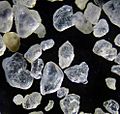Heinrich event facts for kids
Heinrich events were times in Earth's past when huge numbers of icebergs broke off from giant ice sheets and floated into the North Atlantic Ocean. These events happened during the very coldest parts of natural climate cycles called Bond Cycles. As the icebergs melted, they dropped rocks and sediment onto the ocean floor.
Scientists know about Heinrich events by studying special dirt samples, called sediment cores, taken from the bottom of the North Atlantic. These cores show layers of poorly sorted, angular rocks. These rocks are called "ice-rafted debris" because they were carried by icebergs and then dropped when the ice melted.
Contents
What Are Heinrich Events?
Heinrich events are named after Hartmut Heinrich, a German scientist who first described them in 1988. These events were massive discharges of icebergs, mainly from the huge Laurentide Ice Sheet that covered much of North America during the last ice age.
When these icebergs melted, they released large amounts of fresh water into the North Atlantic. This fresh water is lighter than salty ocean water. It could have slowed down or even stopped the important ocean currents that help move heat around the planet, like the Atlantic Ocean conveyor belt.
How Do We Know About Them?
Scientists find evidence of Heinrich events by looking at layers of sediment on the ocean floor.
- Ice-Rafted Debris: During these events, icebergs carried rocks and gravel far out into the ocean. When the icebergs melted, these rocks sank to the bottom. Sediment cores from the North Atlantic show thick layers of these rocks, which are different from the finer sediments usually found there.
- Ocean Chemistry: The fresh water from melting icebergs changed the saltiness and temperature of the ocean. Scientists can study tiny sea creatures called foraminifera found in the sediment. Their shells contain chemical clues, like different types of oxygen (isotopes), that tell us about the ocean conditions when they lived.
Heinrich Events and Climate Change
Heinrich events are thought to be a possible trigger for sudden, short periods of cold weather, sometimes called "mini ice ages," that followed longer periods of warming.
- Sudden Cooling: The massive amount of fresh water released by melting icebergs could have disrupted the ocean's circulation patterns. These currents normally bring warm water from the tropics towards the poles. If they slowed down or stopped, it would lead to much colder temperatures in places like Europe and North America.
- The Younger Dryas: One famous example of a sudden cold snap is the Younger Dryas period. This brief cold period happened about 12,800 to 11,500 years ago. Many scientists believe it was caused by a Heinrich-like event, possibly when a large lake of meltwater from the North American ice sheets suddenly drained into the Atlantic.
While the collapse of the North American ice sheets is a leading idea for the Younger Dryas, scientists are still studying other possible causes. Understanding Heinrich events helps us learn more about how Earth's climate can change very quickly.
Images for kids
-
The H1 Heinrich event happened around 16,000 years ago during the Pleistocene epoch. This graph shows how temperatures changed after the last major ice age, based on ice cores from Greenland.
-
This image shows today's ocean circulation. The Gulf Stream, on the far left, is part of this system and might have changed during Heinrich events.
See also
 In Spanish: Eventos Heinrich para niños
In Spanish: Eventos Heinrich para niños







